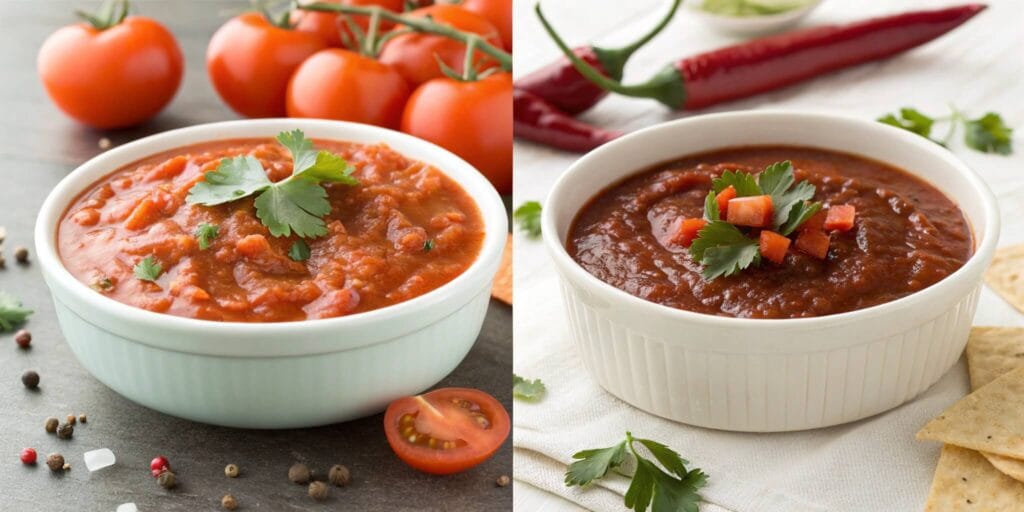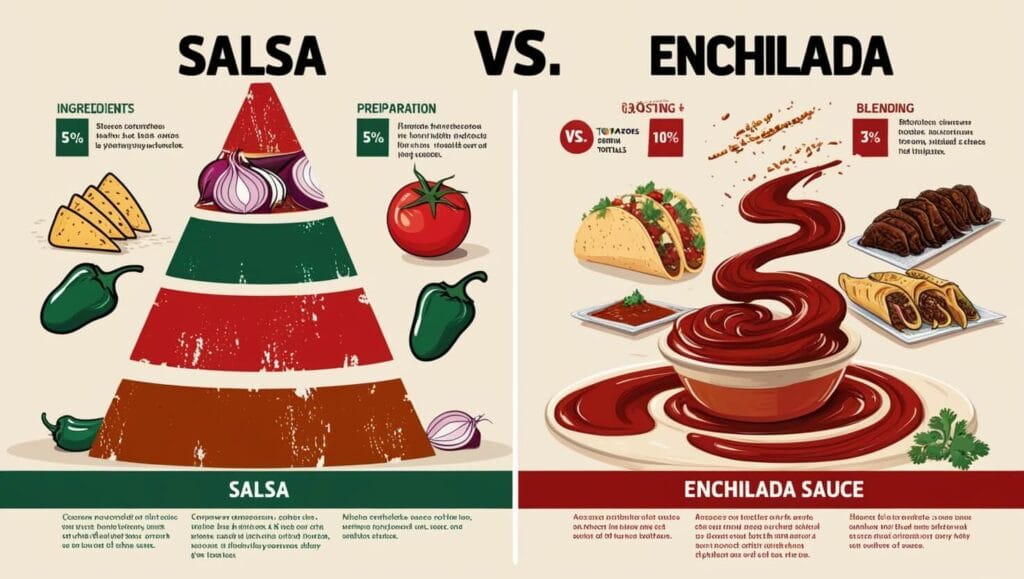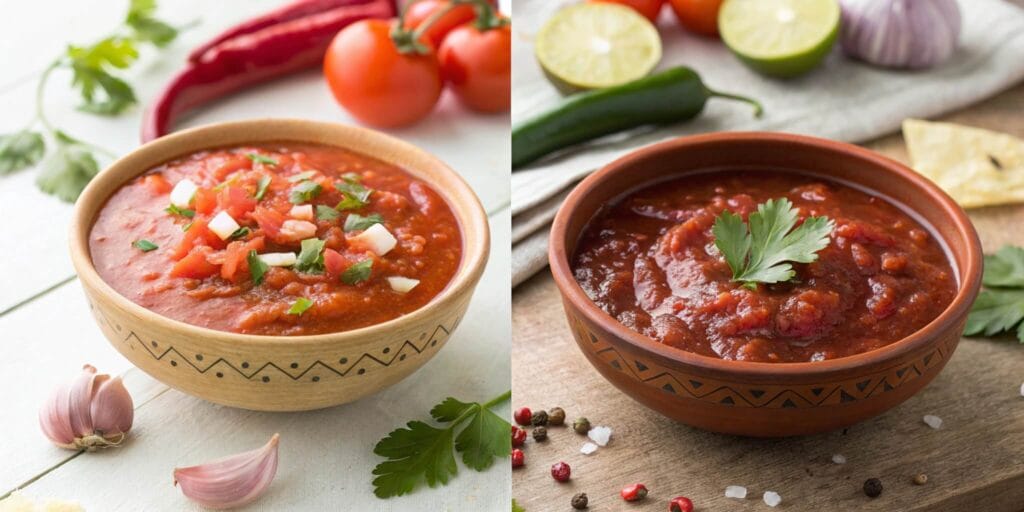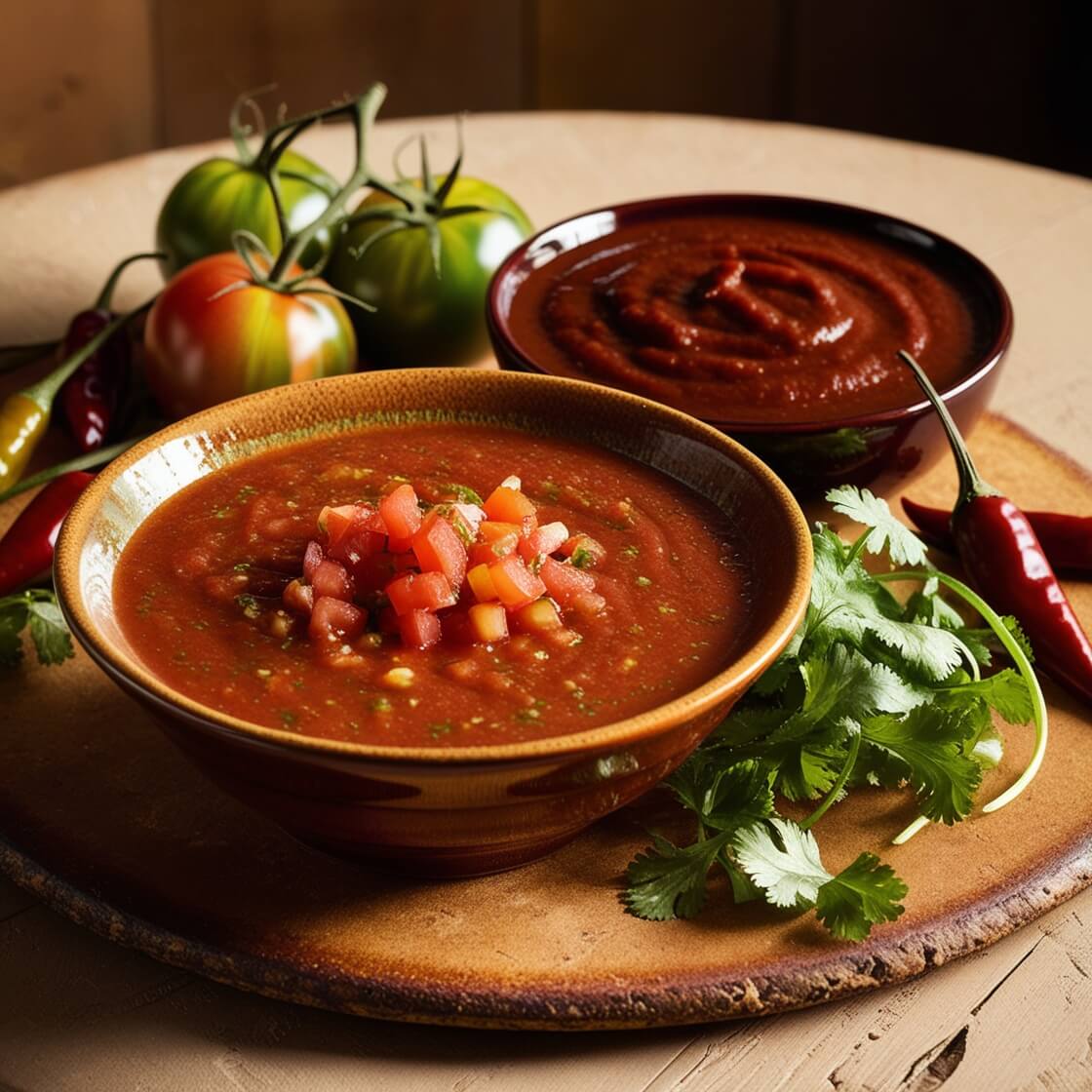Introduction
Mexican cuisine is bursting with flavor, variety, and unique ingredients. Among its culinary stars, salsa and enchilada sauce often take center stage. But have you ever wondered, “What’s the difference between salsa and enchilada sauce?” While they share some similarities, these two staples are distinct in their ingredients, preparation, and uses. This article will take you on a flavorful journey, comparing and contrasting salsa and enchilada sauce in every delicious detail. From their origins to their unique culinary roles, you’ll gain a clear understanding of what sets them apart and how to use them in your kitchen.
Let’s dive in!
Understanding Salsa
Salsa, which means ‘sauce’ in Spanish, is a popular part of Mexican cooking with a long history. It dates back to the Aztec, Mayan, and Inca civilizations, where people made it by mixing tomatoes, chilies, and spices. Over time, salsa has become loved all around the world, with many different versions.
Most salsas are made with fresh ingredients like tomatoes, onions, cilantro, lime juice, and chilies. The ingredients can change depending on the type of salsa, but what makes it special is its fresh, raw taste. Salsa is a great match for chips, tacos, and many other foods.
Types of Salsa
There isn’t just one type of salsa; there’s a variety for every palate! Here are some of the most popular:
- Fresh Salsa (Pico de Gallo): Made with diced tomatoes, onions, and cilantro, pico de gallo offers a chunky texture and a bright, zesty flavor.
- Cooked Salsa: This type involves simmering tomatoes and chilies, creating a deeper, richer flavor perfect for cooking.
- Salsa Verde (Green Salsa): Made with tomatillos instead of tomatoes, salsa verde delivers a tangy and slightly sweet profile.
- Fruit Salsas: Incorporating fruits like mango or pineapple, these salsas provide a sweet and savory twist.
Each type of salsa is designed to bring out the best in specific dishes, from street tacos to grilled chicken.
Cultural and Culinary Uses of Salsa
Salsa isn’t just a condiment; it’s a culinary superstar! It’s commonly served as a dip for tortilla chips, but its versatility doesn’t end there. Use it as a topping for tacos, burritos, and nachos, or mix it into guacamole for an extra burst of flavor. Salsa also doubles as a cooking ingredient, adding zest to soups, stews, and marinades.
Its fresh ingredients and bold flavors make salsa a crowd-pleaser, whether it’s a backyard barbecue or a five-star dining experience. It’s no wonder salsa has become a pantry staple worldwide!
Now that we’ve uncovered the secrets of salsa, let’s move on to its equally intriguing counterpart: enchilada sauce.

Understanding Enchilada Sauce
Enchilada sauce is a bold, flavorful staple in Mexican cuisine, specifically crafted to coat and complement enchiladas. Unlike salsa, enchilada sauce is primarily a cooked sauce made with a variety of spices, chilies, and sometimes broth or tomato paste. Its rich, savory flavor comes from simmering ingredients together, allowing them to meld into a smooth, cohesive sauce.
Originating from traditional Mexican recipes, enchilada sauce is designed to add depth to dishes like enchiladas, casseroles, and even soups. Its ingredients often include dried or fresh chilies, garlic, onions, and a thickening agent like flour or cornstarch to give it a velvety texture.
Types of Enchilada Sauce
Enchilada sauce comes in several varieties, each with its own unique flavor and culinary application:
- Red Enchilada Sauce: This classic version gets its color and flavor from dried red chilies, tomatoes, and a mix of spices like cumin and oregano. It’s commonly used in traditional enchilada recipes.
- Green Enchilada Sauce: Made with green chilies or tomatillos, this sauce is tangier and lighter, pairing well with chicken and seafood dishes.
- White Enchilada Sauce: A creamy variation often made with sour cream, cheese, and mild spices, perfect for adding richness to casseroles.
These types ensure there’s an enchilada sauce for every flavor preference and dish.
Culinary Applications of Enchilada Sauce
Enchilada sauce is a cooking essential rather than a dip or topping. Its primary purpose is to coat tortillas in enchilada recipes, infusing them with bold, smoky flavors. It can also be used as a base for soups, baked dishes, and marinades.
Unlike salsa, which is typically served fresh, enchilada sauce’s cooked nature makes it a better choice for recipes requiring deeper, more cohesive flavors. As you explore what’s the difference between salsa and enchilada sauce, you’ll notice that enchilada sauce shines in cooked dishes, adding warmth and complexity.
Salsa vs. Enchilada Sauce: Key Differences
Differences in Ingredients
The primary difference between salsa and enchilada sauce lies in their ingredients. Salsa is often made from fresh, raw ingredients like tomatoes, onions, and lime juice. In contrast, enchilada sauce is a cooked blend of chilies, broth, and spices, often thickened with flour or cornstarch.
Salsa’s bright and tangy flavors stem from its fresh ingredients, while enchilada sauce has a deeper, smokier profile due to its cooked preparation. For instance, salsa verde uses tomatillos for a tangy punch, while green enchilada sauce relies on green chilies for heat and flavor.
Preparation Methods
Preparation plays a huge role in distinguishing salsa from enchilada sauce. Salsa is typically blended or chopped, then served raw or lightly cooked. On the other hand, enchilada sauce requires simmering or slow cooking to develop its rich, cohesive flavor.
If you’ve ever wondered, “What’s the difference between salsa and enchilada sauce?” preparation methods are one of the clearest distinctions. Salsa’s simplicity makes it a go-to for quick meals, while enchilada sauce requires more time and effort but delivers a heartier result.
Flavor Profiles and Consistency
Salsa is known for its fresh, zesty taste and often has a chunkier texture, depending on the type. In contrast, enchilada sauce is smooth, with a bold and smoky flavor that pairs perfectly with tortillas and baked dishes.
These contrasting textures and flavors also influence their use in recipes. Salsa is ideal for topping tacos or dipping chips, while enchilada sauce is better suited for soaking tortillas and slow-cooked meals.
Intended Uses in Recipes
Salsa and enchilada sauce serve very different purposes in cooking. People primarily use salsa as a dip, topping, or side to enhance dishes with its bright, fresh taste. In contrast, cooks rely on enchilada sauce as a key ingredient in recipes, especially for baked or simmered dishes.
Understanding what’s the difference between salsa and enchilada sauce is essential for picking the right ingredient for your dish. While salsa shines in casual, fresh dishes, enchilada sauce is a must for more robust, hearty recipes.

Nutritional Comparison
Calorie and Nutrient Differences
When it comes to nutrition, salsa and enchilada sauce offer different benefits. Salsa, particularly the fresh, homemade kind, is often low in calories and packed with vitamins and antioxidants. Ingredients like tomatoes, onions, and cilantro are naturally nutrient-dense, providing vitamin C, potassium, and fiber. On the other hand, enchilada sauce tends to be higher in calories and sodium due to added oils, thickeners, and seasonings.
For example, one cup of fresh salsa typically contains around 50 calories, while the same amount of enchilada sauce can have 100-150 calories, depending on the recipe. Store-bought versions of both may contain preservatives and additional sodium, so it’s always worth checking the label.
Health Considerations
From a health perspective, salsa is often seen as the lighter, healthier option. Its raw ingredients maintain their natural nutrients, making it ideal for those aiming to reduce calorie intake while enjoying bold flavors. Conversely, enchilada sauce’s thicker texture and richer taste come from cooking oils and flour, which can add fat and carbohydrates.
If you’re asking, “What’s the difference between salsa and enchilada sauce?”, nutrition is an essential consideration. For a healthier twist, try making both sauces at home to control ingredients and reduce unnecessary additives.
Substituting Salsa for Enchilada Sauce
When is Substitution Possible?
It’s common to wonder, ‘Can I use salsa instead of enchilada sauce?’ The answer depends on the recipe. Salsa works as a substitute in some dishes, especially if you’re aiming for a lighter or tangier option. For example, you can use salsa verde instead of green enchilada sauce in casseroles or baked dishes. However, adding a thickener like cornstarch might be necessary to achieve the right consistency.
Challenges in Substitution
While salsa can replace enchilada sauce in some cases, there are challenges to consider. Enchilada sauce’s smooth, rich texture comes from simmering ingredients together, which salsa lacks. Recipes like enchiladas that rely on sauce for soaking tortillas may not work as well with the chunkier texture of salsa.
To address this, you can blend salsa into a smoother consistency or simmer it briefly with additional spices. This adjustment helps retain the recipe’s authenticity while using ingredients you have on hand.
For more flavorful ideas on how to make enchilada sauce at home, check out Kamala Recipes’ Chili Recipe with Enchilada Sauce and Ground Beef. It’s a great starting point to explore creative uses of enchilada sauce in your kitchen!
Salsa Verde vs. Green Enchilada Sauce
Differences in Ingredients and Taste
When comparing salsa verde and green enchilada sauce, the main differences are in the ingredients and how they’re made. Salsa verde, a green salsa, is usually made with raw tomatillos, green chilies, onions, and lime juice. It has a fresh, tangy flavor that’s a big part of Mexican cooking. Green enchilada sauce uses some of the same ingredients but adds garlic, broth, and sometimes a thickener, making it smoother and richer.
If you’re asking, ‘What’s the difference between salsa and enchilada sauce?’ salsa verde and green enchilada sauce show how texture and preparation make them different. Salsa verde is fresh and zesty, while green enchilada sauce is softer with a cooked taste.
Best Uses for Each
Salsa verde is great as a topping for tacos, a dip for chips, or a fresh addition to grilled meats. This flexible sauce improves almost any dish with its bright, tangy flavor. On the other hand, green enchilada sauce works best in cooked dishes like enchiladas, casseroles, and soups.
While you can sometimes use them in place of each other, knowing their differences helps you pick the right one for your recipe. Whether you want freshness or rich flavor, both add something special to Mexican-inspired meals.

FAQs Section
Can You Use Salsa as Enchilada Sauce?
Yes, but with a few adjustments! Salsa, especially salsa verde, can replace enchilada sauce in a pinch, but you’ll need to modify it slightly. For example, blending salsa and simmering it with additional spices can create a smoother, richer sauce suitable for recipes like enchiladas.
What Makes Enchilada Sauce Unique?
Enchilada sauce stands out for its cooked, savory flavor and smooth texture, achieved by simmering ingredients like chilies, broth, and flour. Unlike salsa, cooks use it not as a topping but as a key ingredient in baked or simmered dishes.
Is Salsa Always Fresh?
Not always! While many salsas are fresh, some types, like cooked salsa or jarred varieties, undergo cooking or processing. This gives them a deeper flavor but moves them closer to the texture and preparation of enchilada sauce.
For more cooking tips and recipe inspiration, explore Kamala Recipes’ Chili Recipe with Enchilada Sauce and Ground Beef. It’s a great way to experiment with these flavorful sauces!
Homemade vs. Store-Bought Options
Benefits of Homemade Salsa and Enchilada Sauce
Making these delicious staples at home is one of the best ways to enjoy them. Homemade salsa allows you to choose fresh, high-quality ingredients and try different combinations of tomatoes, chilies, and herbs to match your taste. It’s also free from the preservatives and added sugars often found in store-bought options.
Homemade enchilada sauce provides similar benefits, letting you adjust the spice level and thickness to your liking. You can use fresh chilies, tweak the seasoning, and opt for healthier alternatives to flour as a thickener. Best of all, it delivers a richer, more authentic flavor compared to store-bought varieties.
Convenience of Store-Bought Options
Store-bought salsa and enchilada sauce are very convenient. Salsa jars are great for quick get-togethers, and canned enchilada sauce helps save time when making big meals. But these packaged options often have extra salt and preservatives, which might not be the best for healthy eating.
If you’ve ever asked, ‘What’s the difference between salsa and enchilada sauce?’ the choice between homemade and store-bought adds another difference. Store-bought options are quick and easy, but homemade versions taste better and let you control the ingredients.
Exploring Regional Variations
Regional Twists on Salsa
Salsa recipes vary a lot across Mexico, based on local ingredients and cooking traditions. In northern areas, people make salsas with roasted tomatoes and chilies for a smoky flavor. Coastal regions often use tropical fruits like mango or pineapple to create sweet and spicy salsas. These differences show how salsa can be a creative and versatile dish.
Regional Variations in Enchilada Sauce
Enchilada sauce shows the rich variety of Mexican cooking. In Oaxaca, cooks often use mole sauce on enchiladas, mixing chocolate, nuts, and chilies for a deep flavor. In the Yucatán Peninsula, they top enchiladas with a sauce made from achiote paste, giving it a reddish color and earthy taste.
Learning about these regional styles helps you better understand Mexican cuisine. When thinking about the difference between salsa and enchilada sauce, these local variations show how each sauce can adapt to different dishes.
For more inspiration on homemade sauce recipes, check out Kamala Recipes’ Chili Recipe with Enchilada Sauce and Ground Beef, which blends traditional flavors with modern twists!


